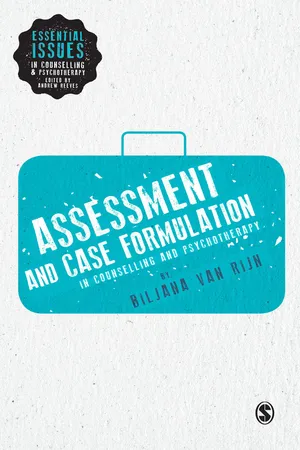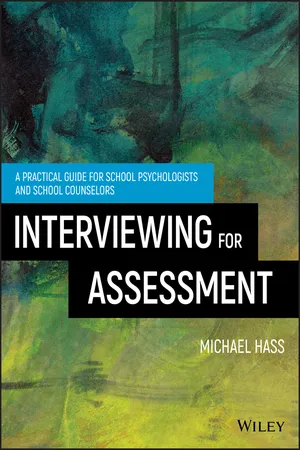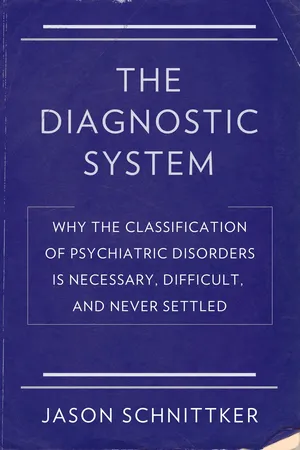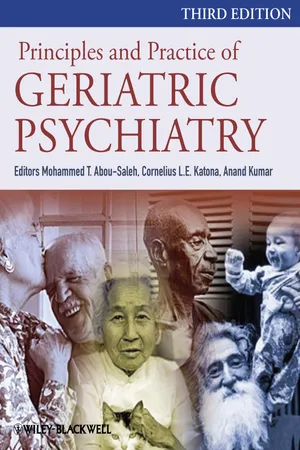Psychology
Diagnosing Psychological Disorders
Diagnosing psychological disorders involves the systematic assessment of an individual's thoughts, emotions, and behaviors to identify the presence of a mental health condition. This process often includes clinical interviews, psychological testing, and observation of the individual's functioning. The goal is to accurately classify and understand the nature of the disorder, which can guide treatment and support.
Written by Perlego with AI-assistance
Related key terms
9 Key excerpts on "Diagnosing Psychological Disorders"
- Biljana van Rijn(Author)
- 2014(Publication Date)
- SAGE Publications Ltd(Publisher)
Importantly, there is an acknowledgement in DSM-5 that the aim of diagnosis is not to provide a categorical truth but to have clinical usefulness and to assist in assessment, formulation and treatment planning. The importance of clinical formulation is highlighted and clinicians are advised against just looking at the list of symptoms contained in the manual. Instead, they are advised to obtain a clinical history and a summary of psychological, social and biological factors that may have contributed to the development of the mental disorder. Cultural considerations are referred to in each diagnostic category.The current definition of the term ‘mental disorder’ reflects these developments (APA, 2013: 20):A mental disorder is a syndrome characterised by clinically significant disturbance in an individual’s cognition, emotion regulation or behaviour that reflects a dysfunction in the psychological, biological, or developmental processes underlying mental functioning. Mental disorders are usually associated with significant distress or disability in social, occupational, or other important activities. An expectable or culturally approved response to a common stressor or loss, such as the death of a loved one, is not a mental disorder. Socially deviant behaviour (e.g. political, religious, or sexual) and conflicts that are primarily between the individual and society are not mental disorders unless the deviance or conflict results from a dysfunction in the individual, as described above.Limitations of diagnosis
Critique of formal diagnosis, particularly in counselling and psychotherapy practice, focuses on the issues of power and stigmatisation as well as questions about the validity of diagnosis, its applicability in different cultural contexts, a lack of usefulness for clinical practice and the impartiality and validity of the research evidence on which diagnostic categories are based.Historically, the diagnosis of any mental health condition led to stigmatisation with negative consequences in terms of employment and general prejudice. This is gradually changing in the UK as depression, anxiety and trauma are discussed more widely. Counselling is becoming a part of mainstream culture and provision, available in primary care health services and through employers.- eBook - ePub
- Matt Field, Sam Cartwright-Hatton(Authors)
- 2015(Publication Date)
- SAGE Publications Ltd(Publisher)
This enables doctors to quickly and efficiently check that a patient has the symptoms of a given disorder (e.g. influenza or tonsillitis), and then make a diagnosis that determines the most appropriate treatment. The same logic has been applied to the classification of psychological disorders, resulting in the DSM and ICD. Looking beyond the individual patient, the idea is that classification and diagnosis help us to understand psychological disorders and devise better treatments for them. It would be impossible for us to diagnose, understand, conduct research into and treat schizophrenia if we could not agree on what schizophrenia was, and what its defining features were. This is discussed in Box 1.3. Both the DSM and the ICD are constantly being refined. As new research is published we gain a better idea of the key features of different disorders: we learn about which disorders are distinct from each other and which share sufficient overlap with other disorders to suggest that they should be categorised together. In the next section, we consider the general limitations of this approach to describing and categorising psychological disorders. Figure 1.1 Is it appropriate to categorise psychological disorders in the way that we do? Box 1.3 Essential experience What if we didn’t categorise psychological disorders? Imagine a parallel universe in which psychological disorders are not categorised, everyone is treated as an individual and similarities between people are ignored. A patient, Bob, goes to see his doctor, complaining of hearing voices that tell him what to do. Bob is also paranoid that the government are following him. While talking to Bob the doctor notices that his mood seems ‘flat’ (he doesn’t react to things that would make other people happy or sad), and he doesn’t seem to have washed or changed his clothes for several weeks. The doctor has no idea what to do, so he just tries different treatments at random - eBook - ePub
- Naomi Moller, Andreas Vossler, David W Jones, David Kaposi, Naomi Moller, Andreas Vossler, David W Jones, David Kaposi(Authors)
- 2020(Publication Date)
- SAGE Publications Ltd(Publisher)
This international manual covers both mental and physical health. Another manual, published by the American Psychiatric Association (APA), is also extensively used internationally: the Diagnostic and statistical manual of mental disorders (DSM), currently in its fifth edition (DSM-5; APA, 2013). This chapter will focus on the latter manual because it has a significant international impact (e.g. on research and on other manuals, such as the ICD) and because it has been the focus of significant scholarship and research. In medicine, a diagnosis is used to: categorise the type of problem a person has identify treatment options and their likely outcome provide access to other kinds of support inform research inform the planning of health services. The following quotations are from two people who received a psychiatric diagnosis. The first, Mike Shooter, is a psychiatrist who chose to speak openly about his experiences of depression, while the second is a mental health service user. When I was told that I was depressed it gave me a framework of understanding and a first grip on what was happening, not just for me but for my wife and children who had been equally frightened by my behaviour. (Shooter, 2010, p. 366) You only have to look at the definitions given in ICD 10 and DSM IV and read comments such as ‘limited capacity to express feelings … callous unconcern for others … threatening or untrustworthy’ … [o]ne thing that these comments have in common is that they are not helpful in any way. (Castillo, 2003, p - eBook - ePub
Interviewing For Assessment
A Practical Guide for School Psychologists and School Counselors
- Michael Hass(Author)
- 2018(Publication Date)
- Wiley(Publisher)
Another important critique of classifications is their lack of treatment validity (Kamphaus et al., 2013; Timimi, 2014). Simply put, knowing someone's classification or the name of his or her disorder appears to be of only limited value in deciding on a treatment or intervention. There is limited evidence that treatments, both psychosocial and psychopharmacological, are disorder specific (Timimi, 2014). In other words, an intervention such as using self-talk to help cope with distress or positive reinforcement from a teacher is not specifically tied to a particular disorder but is rather helpful for a variety of different problems.Despite these critiques, the use of diagnoses (either DSM or IDEIA) continues to be pervasive in both community and school settings. Although school-based practitioners must be familiar with these critiques, it is important that they also be thoroughly familiar with diagnostic schemas such as the DSM and IDEIA and their use. This allows communication with other mental health professionals and, more importantly, sometimes classification allows children access to needed services (Whitcomb & Merrell, 2013). The rest of this chapter will focus in more depth on these systems and good practices for interviewing for classification.FRAMEWORK OF THE DSM-5
Psychoanalytic theory heavily influenced the first two editions of the DSM. Starting with DSM-III, this was replaced by an atheoretical and descriptive approach to classification (Tsou, 2016). This approach continued with later versions of the DSM, including the current DSM-5 (American Psychiatric Association [APA], 2013). The descriptive approach taken by the DSM was motivated by the goal of making diagnoses more reliable and to allow its use by clinicians of different theoretical orientations (Tsou, 2016).Prior DSMs conceptualized disorders as having five dimensions or axes. Axis I included all disorders except intellectual disabilities and personality disorders, which were placed in Axis II. Axis III included medical or health conditions that might co-occur with the primary disorder, and Axis IV included psychosocial stresses or circumstances that contributed to the disorder in some way. Lastly, Axis V consisted of a global assessment of functioning or impairment. The DSM-5 - Susan Cave(Author)
- 2005(Publication Date)
- Routledge(Publisher)
2
Classification, assessment and diagnosis
BackgroundDiagnostic and Statistical Manual of Mental Disorders (DSM)Axes I and II: Major categoriesInternational Classification of Diseases (ICD)Clinical assessment proceduresEvaluation of classification and diagnosisBackground
One of the key features of the scientific approach to any subject is that it is systematic. The subject matter is grouped into categories of items that share similar features, or subjected to some other form of logical organisation that makes it easier to see patterns or consistencies in what is observed. The natural sciences have long employed classification systems of various sorts, such as the periodic table of the elements used in chemistry or the phylogenetic systems of the biological sciences. In the 19th century, medical science began to make progress by identifying different illnesses and providing different forms of treatment for them. By comparison, there was very little consistency in the approach to abnormal behaviour. In Britain, a classification scheme was produced by the Statistical Committee of the Royal Medico-Psychological Association, but never utilised by the members. In Paris and America similar schemes also failed to gain acceptance.One of these early schemes was that produced by Kraepelin (1883), who is often regarded as the founder of modern psychiatry. His system identified symptom groups or syndromes, which he considered to have organic causes, i.e. they were physically based. For example, severe mental illnesses were divided into dementia praecox (now known as schizophrenia), which was thought to result from a chemical imbalance, and manic-depressive psychosis, which was thought to result from metabolic irregularities. Kraepelin’s system was the basis from which modern diagnostic schemes developed.There are two major schemes in use at present. These are: the Diagnostic and Statistical Manual of Mental Disorders- eBook - ePub
- Jill Peay(Author)
- 2010(Publication Date)
- Routledge-Cavendish(Publisher)
The focus here is on a tension within the topic between an approach that emphasises a quasi-scientific basis, with all of the seeming certainty that that embraces, and one which places much greater stress on what is not yet known or understood (see Kendell, 2001 and Cheng, 2001, implicitly supporting the scientific view, and Turner, 2003, for a contrary view). The former approach might be typified by frequent resort to the accepted1 As Kendell points out (2001:490) even DSM IV objects to the term as representing an anachronistic and reductionist mind/body dualism.international classifications of psychiatric disorders, namely the World Health Organization’s International Classification of Diseases, Edition 10 (ICD 10) and the American Psychiatric Association’s Diagnostic and Statistical Manual, 4th Edition (DSM IV). ICD 10 has 17 categories of disease, with ‘mental and behavioural disorders’ being but one of these categories. It adopts a uniaxial approach. DSM IV relates only to those disorders treated by American psychiatrists and clinical psychologists, and is a product of the work of those professional bodies. It adopts a multi-axial approach.2 But both ICD 10 and DSM IV encourage the presumption that a disease is present, even if it has not yet been identified. Both classificatory systems, as is revealed by their not infrequent revisions, have been subject to clarification and extension. One illustration of this would be the emergence of social anxiety disorder. Not officially recognised until 1980, this disorder only achieved an adequate definition in the 1987 revision of DSM; yet now social anxiety disorder is reported in the US to be the third most common psychiatric diagnosis after alcoholism and depression. As with the discussion of crime, the boundaries of mental disorder are subject to expansionary pressures (Horwitz and Wakefield, 2007).3In contrast, and arguably at the polar opposite, is a much more hesitant approach, which would stress the relative historical newness of psychiatric diagnosis and reject any notion of hard and fast classifications that are in any sense akin to our ability to diagnose other disorders, such as diabetes or smallpox (see, for example, Bentall 2003). Indeed, Turner has argued that ‘the claim that mental illness is the same in all cultures is an implicit assumption, rather than an empirical finding’ (2003:472). In so doing he draws on the work of the American philosopher Donald Davidson, who has argued that ‘there cannot, in any useful sense, be a science of the mental because of the impossibility of either strict psychological or strict psychophysical laws’ (ibid); in essence, it is implausible to think of a science of mental states. Trying to disentangle the inevitably tangled web of what one means, when one says something, from what one believes, makes hazardous any claims to the elements of scientific rigour traditionally associated with diagnosis. Where the assessment of minor mental disorders and personality disorders is based on how people live their lives and what they believe in and value, then it is problematic to reduce these to an agreed vocabulary. If diagnosis - eBook - ePub
The Diagnostic System
Why the Classification of Psychiatric Disorders Is Necessary, Difficult, and Never Settled
- Jason Schnittker(Author)
- 2017(Publication Date)
- Columbia University Press(Publisher)
DSM exceeded the bounds of the authors’ original intent?DIAGNOSING VERSUS TREATING DISORDERSThe DSM is a powerful tool for creating disorders and, under some circumstances, for destroying them. But the DSM is fundamentally a tool for diagnosis . And, in this regard, the intentions of the DSM ’s authors are narrow. The DSM is intended to provide guidance for diagnosis, not treatment. The DSM provides some information on course and associated characteristics, befitting its “statistical” name, and, furthermore, the existence of a disorder perhaps implies the disorder is worthy of treatment. Yet the DSM does not, in fact, dictate anything regarding the correct way to treat a case. It is unclear, though, whether the DSM has been received by its audience in such a neutral and descriptive way. A cultural analysis is revealing not only for showing how the DSM creates the lexicon of disorders but also for showing how disorders are discussed and, in effect, what purpose the newly created nouns serve as aspects of language. One question to ask in this regard is whether most of the discussion surrounding psychiatric disorders pertains to diagnosis or treatment.Figure 8.3 shows trends for different verbs preceding specific psychiatric terms, including “treat” and “diagnose” (and, to represent present participles and gerunds, “treating” and “diagnosing”). Two things emerge from these figures. First, mentions of both treatment and diagnosis increased rapidly around 1980, coinciding with the publication of DSM-III . Prior to 1980 clinicians were certainly interested in treating psychiatric disorders and had tools available for doing so. In fact, there were many references to treating psychiatric disorders prior to 1980. Yet robust discussions of treatment appear to have emerged only in tandem with a more cohesive discussion of specific diagnoses. As antecedents to specific disorders, references to “diagnose” and “treat” increased sharply around 1980 and continued to accelerate thereafter. As with the other trends documented thus far, it is difficult to attribute these increases to anything other than DSM-III . The timing is not consistent with major treatment innovations, for example. In the case of major depression, many of the most important innovations—or at least the development of most popular pharmaceuticals—happened well after 1980. Prozac, for instance, was approved in 1987. There was an increase in references to “treatment” around that time, to be sure, but so too was there a sharp increase in 1981. The second panel shows the same analysis for the two most prevalent categories of disorder in DSM-III : anxiety disorders and mood disorders (based on a refinement of the DSM-II category of “neuroses”). Both trends suggest a rapid evolution. The expansion of the lexicon of disorders created by DSM-III - eBook - ePub
- Mohammed T. Abou-Saleh, Cornelius L. E. Katona, Anand Kumar(Authors)
- 2011(Publication Date)
- Wiley(Publisher)
It achieves these objectives by means of an updated list of diagnostic rubrics, a set of glossary-type definitions of disorders, and additional explicit diagnostic criteria. The latter have been developed in two versions: (a) clinical diagnostic guidelines for routine use, allowing sufficient flexibility and discretion in the application of “clinical judgement” in the hospital ward or the out-patient clinic; and (b) diagnostic criteria for research (ICD-10-DCR) providing stringent decision-making rules to increase the specificity of diagnostic classification and thus ensure a high level of sample homogeneity for the purposes of clinical, biological and other research 2. As a result of a great deal of collaboration between the advisers to the World Health Organisation and the several Task Forces that assembled DSM-IV on behalf of the American Psychiatric Association during the last few years of the preparation of both the classifications, there are very few important differences between them. Since the same body of internationally published research experience and literature was available to both sets of experts during the processes of development, those differences that remain are mainly differences of opinion rather than of fact. Some differences reflect the need for ICD-10 to accommodate a much broader base of international experience and opinions than a national classification. In the development of ICD-10, experts from many different cultures and languages were involved from the earliest stages. As in ICD-9, Chapter V deals with “Mental and Behavioural Disorders”, and is intended for the recording of the clinical syndromes as presented and experienced by the patient - eBook - ePub
Handbook of Diagnosis and Treatment of DSM-5 Personality Disorders
Assessment, Case Conceptualization, and Treatment, Third Edition
- Len Sperry(Author)
- 2016(Publication Date)
- Routledge(Publisher)
Impairment in these four elements of personality functioning is rated along a continuum of five levels of functioning and impairment where 0 = little to no impairment; 1 = some impairment; 2 = moderate impairment; 3 = severe impairment; and 4 = extreme im pairment. Moderate or greater impairment is required for diagnosis of a personality disorder. Table 1.1 summarizes these levels of functioning and impairment. Psychodynamic Diagnostic Manual This section briefly describes another clinically valuable alternative to DSM-5 which an increasing number of clinicians utilize in planning and implementing treatment with personality-disordered individuals. The Psychodynamic Diagnostic Manual (PDM) (PDM Task Force, 2006) is a diagnostic framework that characterizes individuals in terms of both their psychodynamics as well as their emotional, cognitive, and social functioning. The purpose of the PDM is to complement the Diagnostic and Statistical Manual of Mental Disorders (DSM) with psychodynamically based descriptions of patterns of personality, global functioning, and symptom formation. It also emphasizes motivational factors that commonly underlie the emergence of particular personality disorders and symptom disorders (depressive disorders) and the ways individuals with these disorders are likely to experience them. While the DSM provides a behavioral description and diagnostic criteria of a specific disorder, the PDM identifies the influences and causes or etiology that underlies that disorder. The PDM attempts to explain how and why those influences are emerging in the present and causing symptoms, and the role of early environment, developmental factors, current stressors, and internal psychological factors
Learn about this page
Index pages curate the most relevant extracts from our library of academic textbooks. They’ve been created using an in-house natural language model (NLM), each adding context and meaning to key research topics.








